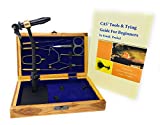The first time I met Norm Zeigler was in his fly shop on Sanibel Island about a decade ago. I was visiting the area for the first time and I wanted to cast to snook in the troughs of the gentle surf along Sanibel and Captiva islands.
Generally speaking, I was a saltwater newbie — a dedicated Rocky Mountain trout angler who was snook-curious. Hell, I was curious about anything that would hit my fly in the surf. Norm, a sincere gentleman and a legend among southwest Florida fly fishers, dropped a half-dozen small-ish flies in my hand and, with a straight face, said to me: “This is the only fly you need.”
I looked down at the little flies — crystal cactus chenille, maribou, some flash and a pair of plastic mono eyes all tied neatly on size 4 saltwater hook. Norm’s own simplistic creation — the Schminnow.
As flies go, it’s among the easiest I tie. As saltwater flies go, it’s downright elementary — kids could tie up a dozen in 20 minutes at the nearest fly fishing expo.
Named for what it’s supposed to imitate — a shrimp or a minnow — the fly is dynamite in the surf, and while it’s tied almost exclusively for snook, I’ve had great luck with the Schminnow on everything from mackerel to speckled trout — anything that might chase baitfish or shrimp in the shallows of southwest Florida’s barrier islands.
The fact that I can easily tie up a couple dozen Schminnows before I hop a plane to Florida makes this fly my go-to searching pattern when I do arrive and finally get to walk the beaches and hunt for cruising snook. Starting as early as March every spring — depending on the weather and the water temperature — and finishing up in October or so, snook move up and down the beaches painfully close to the sand, where they pin bait balls of shrimp and baitfish in the first couple troughs of waves.
As Norm pointed out to me that day I first met him, other patterns will surely work, but given the depth of the water and the bait so close to the beach, the Schminnow is the ideal fly. It’s not too heavy (certainly, if you need some depth, you can tie in a bit of non-lead wire), it’s got all the characterizations of inshore bait that snook look for, and it’s not a chore to cast — there is no chucking and ducking necessary.
Ironically, I had more fun the two days I spent on Sanibel casting the Schminnow on my own than I had on a guided redfish charter the day before I walked into Norm’s shop with an apparent question-mark bubble hovering over my head. Not only did I manage my first few snook from the beach, but I also caught acrobatic ladyfish, rocket-fast spanish mackerel, toothy speckled trout, small-ish redfish, pompano, jacks, angry barracudas and my first-ever lizard fish.
I was convinced that the Schminnow was the secret weapon to barrier island surf casting.
And I still am.
But I’ve also put the Schminnow to work in places where it wasn’t intended to be used. Over the last decade or so, I’ve used Shminnows in various colors to chase skinny-water brown trout in the Rockies, bowfin in the froggy waters of the Southeast and even smallmouth bass on the Snake River here in southern Idaho. It turns out that flies that imitate baitfish are appealing to any predatory fish that eats baitfish, and that the barrier islands along Florida’s Gulf Coast aren’t the only places where that happens.
Still, the Schminnow is definitely most effective in the water it was designed for — emerald green surf licking white sand beaches as that gentle Gulf break comes ashore. Of course, perfect conditions and clear water surely help, and I’ve had maddening days where the snook moving up the beach scoot away at the mere suggestion of a cast. But, even then, the Schminnow stays on the leader, because if the snook won’t play ball, chances are, something else will. And, when you’re casting light fly tackle into the salt, that “something else” will likely pull hard, leap from the water and elicit a giggle or two from the angler on the other end of the rig. And all on a simple size 4 Schminnow, which might be the coolest thing of all.
Credit: Source link































